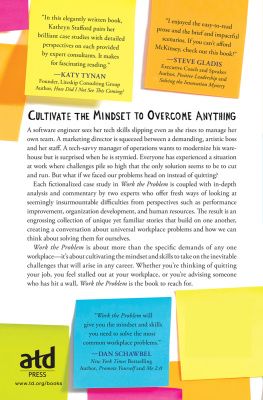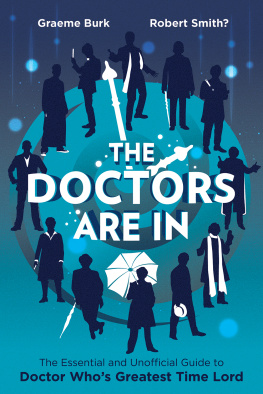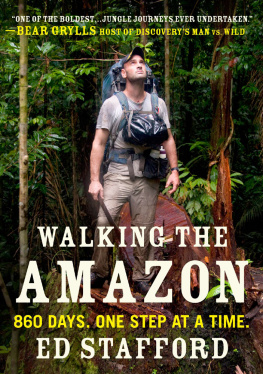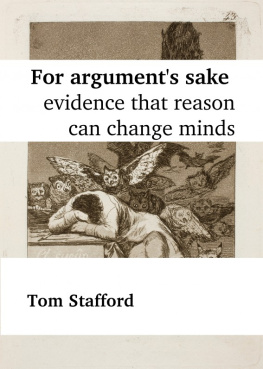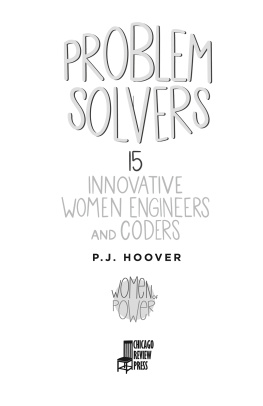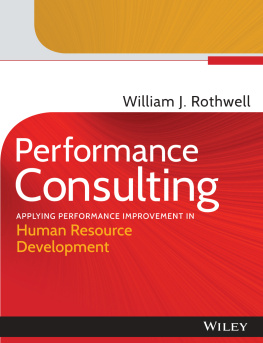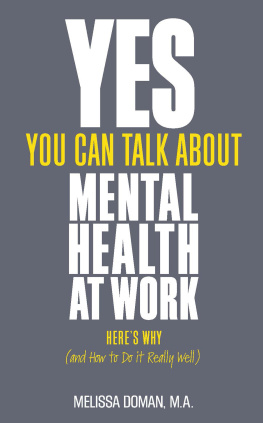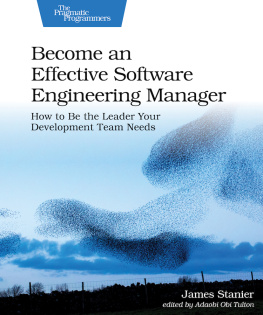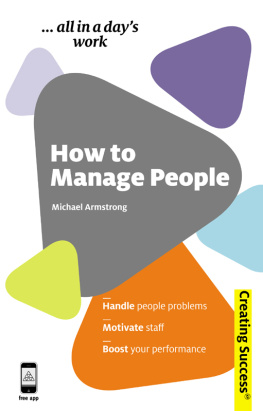2018 ASTD DBA the Association for Talent Development (ATD)
All rights reserved. Printed in the United States of America.
21 20 19 18 1 2 3 4 5
No part of this publication may be reproduced, distributed, or transmitted in any form or by any means, including photocopying, recording, information storage and retrieval systems, or other electronic or mechanical methods, without the prior written permission of the publisher, except in the case of brief quotations embodied in critical reviews and certain other noncommercial uses permitted by copyright law. For permission requests, please go to www.copyright.com, or contact Copyright Clearance Center (CCC), 222 Rosewood Drive, Danvers, MA 01923 (telephone: 978.750.8400; fax: 978.646.8600).
Author photo by Jeffrey Crespi
ATD Press is an internationally renowned source of insightful and practical information on talent development, training, and professional development.
All names, characters, places, or incidents referenced in Work the Problem: How Experts Tackle Workplace Challenges are fictional, and any resemblance to actual persons, entities, places, events, or incidents is coincidental. Further, Work the Problem summarizes the perspectives of the author and contributors only and does not constitute the opinion, policy, approval, or endorsement of ATD.
ATD Press
1640 King Street
Alexandria, VA 22314 USA
Ordering information: Books published by ATD Press can be purchased by visiting ATDs website at www.td.org/books or by calling 800.628.2783 or 703.683.8100.
Library of Congress Control Number: 2018938439
ISBN-10: 1-947308-57-2
ISBN-13: 978-1-947308-57-2
e-ISBN: 978-1-947308-58-9
ATD Press Editorial Staff
Director: Kristine Luecker
Manager: Melissa Jones
Community of Practice Manager, Career Development: Lisa Spinelli and Sue Kaiden
Developmental Editor: Caroline Coppel
Text Design: Iris Sanchez
Cover Design: Faceout Studio, Allison Nordin
Printed by Versa Press Inc., East Peoria, IL
To everyone stuck, panicked, or myopic,
who yearns to be strategic
FOREWORD
In todays world of work, increasingly complex organizational and management structures make being an employee and a manager harder than ever. Were highly interconnected, fiercely competitive, knowledge driven, and global. The markets are chaotic, resource needs are unpredictable, and we are geared for constant change. As a result, employers must be lean and flexible to survive. Employees, in turn, are less likely to trust the system to take care of them over time, and thus less likely to make immediate sacrifices in exchange for promises of long-term rewards. They are more likely to disagree openly with their employers missions, policies, and decisions, and challenge employment conditions and established reward systems.
Traditional sources of authority are also being steadily supplanted by new ones. Seniority, age, rank, and established practice are diminishing. Organization charts are flatter; layers of management have been removed. Reporting relationships are more temporary; more employees are being managed by short-term project leaders instead of organization-chart managers. More transactional forms of authority are also on the rise, such as control of resources, control of rewards, and control of work conditions. Employees look to their immediate supervisors to meet their basic needs and expectations, and freely make demands of their managers. Managers who cannot meet these needs have less and less authority in the eyes of their direct reports.
Meanwhile, most middle managers, like everybody else, have more tasks and responsibilities of their own, along with more administrative duties. In addition, managerial spans of controlthe number of employees officially reporting to each supervisorhave increased, and managers are also more likely to manage remote employees. The breadth and complexity of the work being done by the employees reporting to each manager has probably also expanded.
Most people would rather work in effective organizations with outstanding managers. Organizations that consistently deliver the highest quality and service develop their employees and have clear lines of communication up, down, and across the organization. People want to work for organizations with clear missions, goals, and reporting relationships and flawless processes. Unfortunately, finding that is much harder than ever before, and its getting harder every day.
The 10 case studies in this book offer a look into the sort of complex and interwoven challenges that people face in the workplace today. Much like a business school intensive seminar, Work the Problem applies the classic case study pedagogy to the challenges of workplace dynamics. Grounded in very real-world scenarios, the case study method allows the reader to contemplate 10 different sets of circumstances, each with its own issues, cast of characters, and range of perspectives. The cases deal with such a range of issuescorporate culture, organizational structure, market shifts, technology, change leadership, chain of command, authority and accountability, communication, performance management, and career pathsthat they become relevant to anyone.
While they find themselves in a wide range of positions in a number of different organizations, the key players in each case study are stuck in the middle of a number of stakeholderstheir manager and those they manage as well as various other constituentstrying to negotiate their competing needs and expectations. Most of us would rather avoid these types of conflicts. In the old long-term hierarchical model (the pyramid organization chart), followers took for granted their managers authority and the authority of the employer. As a result, followers were more likely to figure out what to do, and do it, making lots of mistakes along the way, no doubt. But there was more room back then for waste and inefficiency. Not anymore.
These case studies provide so much food for thought, like a shortcut to real workplace experience. Because they are so realistic, there are no 100 percent correct answers and no easy solutions. This is evident in the two commentaries from industry experts following each case study. The nine commentators offer analysis and recommendations in response to the challenges raised in the different scenariostheyre like a professors input on the case, helping the student understand whats really going on, while also providing a framework for how one might begin approaching such a challenge in the real world.
Work the Problem is for those of us in organizations that arent perfect but that we need to work within to navigate and affect change from the middle, and for those who need to become better skilled so we can find and support those organizations that more closely approach our ideal.
Bruce Tulgan
June 2018
ACKNOWLEDGMENTS
To the many creative, smart, caring, talented, deserving, ambitious, thwarted, frustrated, exhausted, reflective, funny, generous, and, most of all, hard-working people who shared their work-life stories with methank you for your time, patience, interest in the project, and anonymity. My hope is that you dont recognize yourselves at all in the following pages, but at the same time you feel vindicated and supported by the commentaries.
Thank you to Sue Kaiden, former ATD Career Development Community of Practice manager, who partnered in guiding this book forward and developing its commentaries. Every subject matter expert appearing here was her inspired choice, and from the start, her interest and energy gave the book project a form, structure, and purpose when my own sense of those things sometimes flagged.

